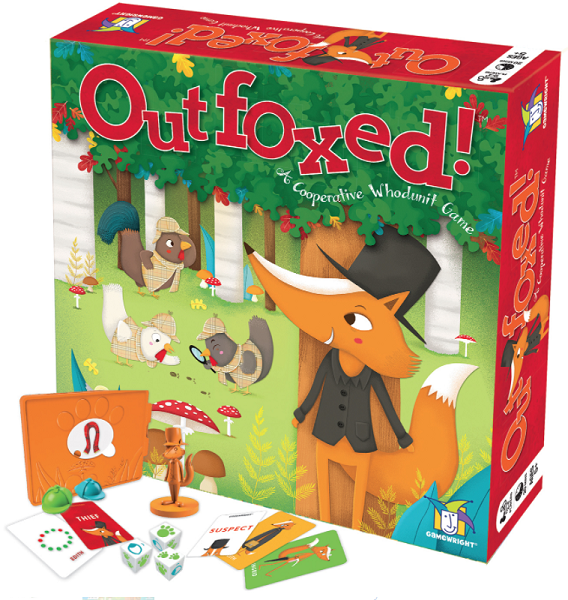Will You Catch the Thief or Will You Be...Outfoxed?

Search for clues and eliminate the suspects one by one before the culprit manages his escape in this cooperative 'whodunit' family game from Gamewright.
Work together as you discover each clue in this creative game that features colorful artwork and a fun tactile component for revealing clues.
Gameplay
The board is set in the middle of the table. It is made up of a grid of squares. Throughout the board are large spaces with paw marks. Each player chooses a detective hat token and places it in the middle of the board. The fox is placed at the start of his path. The sixteen suspect cards are shuffled and placed around the board, facedown. Randomly select two to turn face up. Each suspect card shows a fox with various features such as an umbrella, glasses, or a scarf. You then shuffle the sixteen thief cards and select one. Without looking at it, you slide it into the clue decoder. The decoder has a window that can slide open and shut. Make sure it is closed. Each thief card corresponds to one of the suspects.
On your turn, you start by announcing if you will search for clues or reveal suspects. Then you roll the three dice. If you are searching for clues you are trying to roll paw prints. If you are revealing suspects you are trying to roll eyes. You may roll up to three times, setting dice aside that show the icons you need. If you do not get the icons you need on all three dice by your third roll, the fox moves forward three spaces and your turn ends.
If you are searching for clues and you roll paw prints on all three dice, you count up the number of paws you rolled and may move your detective hat token that many spaces. If you land on an empty paw print space, you draw a facedown clue token. This will show one of the features that can be shown on the suspect cards. You place the token on top of the decoder’s window and slide the window open. Each token has a little hole. If you see a green circle through the hole, it means the thief’s suspect card has that feature. If there is no green circle, it means the thief does not have that feature. You may discard any revealed suspect cards that do not fit this new clue. Then you shut the window again of the decoder, and place the clue token on the paw space your token occupies.
If you are revealing suspects and you roll three eyes by the end of your third roll, you flip two suspect cards face up. You must attempt to remember which clue tokens already on the board were features present on the thief and which ones were not, and may discard any revealed suspects that the clue tokens exonerate.
The game ends once you have deduced who is the thief and revealed the thief card. You win if your deduction was correct and lose if you made a mistake. You also lose if the fox reaches the end of the path before you have discovered the thief.

Review
Outfoxed! has fantastic production quality and a really clever mechanical component. There’s not too many cooperative deduction games out there, and this one is a solid blend of the two genres. The clue decoder is such a cool game piece, that’s fun to play with, and does a great job of giving you clues.
The game plays quite quickly. There are definitely some turns that are less exciting than others if you don’t roll enough paws to reach a paw space but it’s such a fast game that this doesn’t feel particularly onerous, plus everyone is involved in eliminating suspects and discarding cards based on new clues.
Gamewright always does a great job on components but they really went above and beyond here, with an adorable fox figure, the nicely solid detective hat tokens, the bright and colorful board, and the suspect cards that have a lot of fun personality.
This is definitely a children’s game, both from the theme to the difficulty level (it’s quite hard to lose as the fox seldom triggers), and while you’re not going to have adults choosing to play this game on their own, it’s great for families and parents can enjoy playing this one with their children, who can also play it on their own. There are ideas here that could definitely be retooled to a more grownup game, but as a children’s game it’s quite delightful.
Pros: Great components, the decoder works quite well, fun light deduction elements, good for families
Cons: Not something grownups will choose to play by themselves
Disclosure: we received a complimentary review copy of this game.







